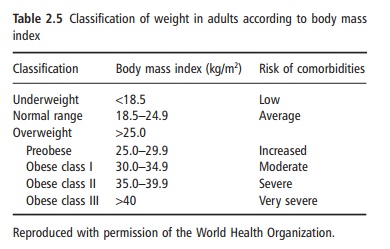Chapter: Introduction to Human Nutrition: Body Composition
Weight/height indices - Doubly indirect methods in Body composition techniques
Weight/height indices
A weight/height index aims to correct body weight for height. As a measure of body composition, for example body fat, a weight/height index should have a high correlation with body fat, but also a low cor-relation with body height, otherwise in short people body fat would be systematically overestimated or underestimated.
In the literature, a number of weight/height indices have been proposed. Examples are the Quetelet index or body mass index (BMI: weight/height2), the Broca index [weight/(height – 100)], and the Benn index (weight/heightp, in which the exponent p is popula- tion specific). The Quetelet index or BMI is the most widely used index today. Its correlation with body fat is high (depending on the age group r = 0.6–0.8) and the correlation with body height is generally low. The World Health Organization (WHO) promotes the BMI as a crude indicator for weight judgment. In Table 2.5 the cut-off points for underweight, normal weight, overweight, and obesity according to the WHO are given. These cut-off values are based on the relation of BMI with mortality and with risk factors for disease as found in Caucasian populations. For non-Caucasian populations other cut-off values may apply (WHO, 2004).

The cut-off values for BMI as in Table 2.5 cannot be used in children. In younger children, weight com-pared with height is relatively low, and so is the BMI. During growth, the increase in weight is larger than the increase in height and, consequently, the BMI increases with age during the pubertal phase of life. There are age-related BMI cut-off values for obesity for children.
The BMI can also be used as a predictor for the percentage of body fat. Several studies have been pub-lished in which a good relationship between the BMI and the amount of body fat (either as fat mass or as body fat percentage) was demonstrated. The relation-ship between BMI and body fat percentage is age and gender dependent and is different among certain ethnic groups. When using such age- and gender-specific prediction equations, body fat per-centage can be predicted with an error of 3–5%. This error is similar to the prediction error of other doubly indirect methods, for example skinfold thickness or total body bioelectrical impedance measurements. The disadvantage of these prediction formulae is that they obviously cannot be used in certain subjects or groups of subjects such as pregnant women or body-builders. However, other predictive methods also have their limitations in these subjects.
TBW can also be predicted from weight and height, and numerous prediction formulae have been pub-lished. The standard error of estimate of these equa-tions is, however, considerable.
Related Topics